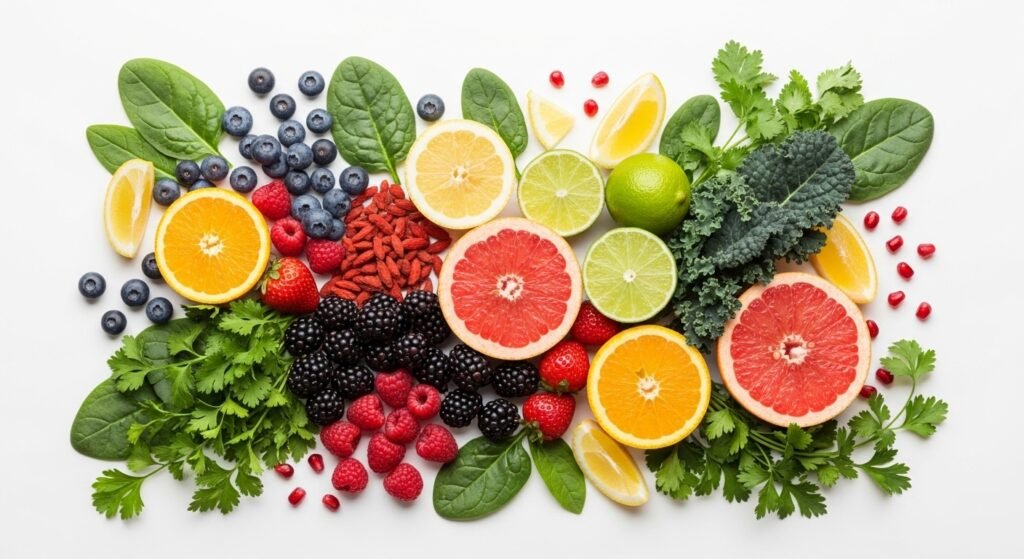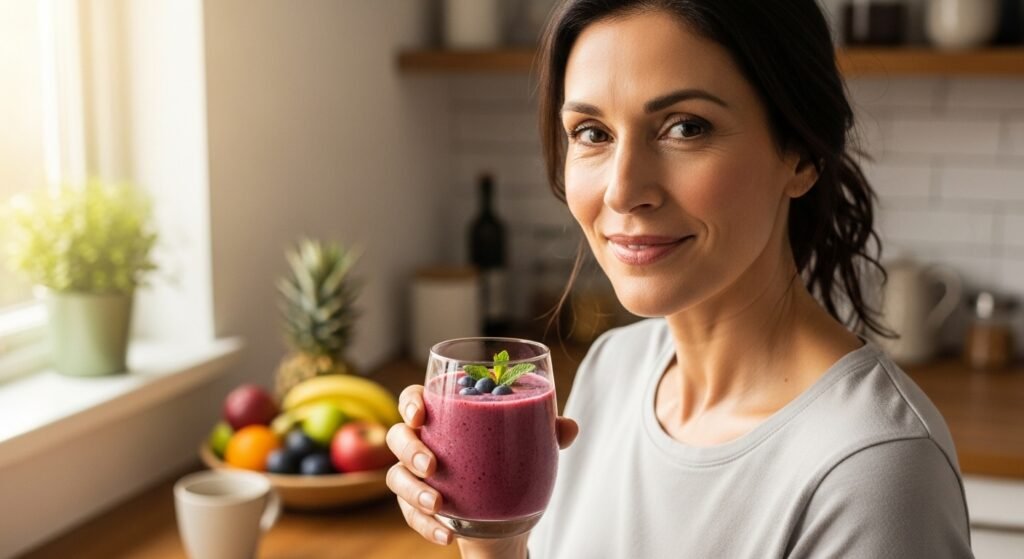Page Contents
ToggleHave you noticed your energy levels dropping or your skin showing more signs of aging lately? If you’re between 30 and 60, your body is constantly battling invisible enemies called free radicals. The good news is that antioxidant foods can be your natural defense system, protecting your cells from damage and helping you feel vibrant at any age. Let’s explore how these powerful nutrients work and which foods pack the biggest protective punch for your health.
Understanding Antioxidant Foods and Their Benefits
Antioxidant foods contain compounds that neutralize free radicals – unstable molecules that damage cells and accelerate aging. Think of antioxidants as your body’s cleanup crew, constantly working to prevent the cellular rust that leads to chronic diseases and premature aging. Your body produces some antioxidants naturally, but this production decreases with age, making dietary sources increasingly important.
The most powerful antioxidants include vitamins C and E, beta-carotene, selenium, and polyphenols. Each works differently to protect various parts of your cells. When you consume a variety of antioxidant-rich foods, you create a comprehensive defense network that supports everything from heart health to brain function.
If you want a supplement that goes beyond food alone, our Vital Force Review 2025 explores a natural formula designed to boost immune defense, detox pathways, and overall vitality.
Best Sources of Natural Antioxidants
Nature provides an abundance of best sources for antioxidants, with colorful fruits and vegetables leading the pack. Berries reign supreme – blueberries, strawberries, and raspberries contain anthocyanins that protect brain cells and improve memory. Just one cup of blueberries provides more antioxidant power than most people get in an entire day.
Other antioxidant powerhouses include:
- Dark leafy greens (spinach, kale)
- Colorful vegetables (bell peppers, carrots, beets)
- Nuts and seeds (pecans, walnuts, sunflower seeds)
- Dark chocolate (70% cacao or higher)
- Green tea and coffee
- Herbs and spices (oregano, cinnamon, turmeric)
The key is variety – different colored foods provide different types of antioxidants, each offering unique protective benefits.

For those who struggle to consistently eat a wide range of antioxidant-rich foods, supplements like the one in our Vital Force Review 2025 can help fill the gaps and support long-term resilience.
Health Benefits You Can Actually Feel
The health benefits of consuming antioxidant foods extend far beyond theoretical protection. Many people report increased energy, clearer skin, and improved mental clarity within weeks of boosting their antioxidant intake.

Research shows these foods can:
- Reduce inflammation throughout your body
- Support heart health by preventing LDL cholesterol oxidation
- Enhance immune function
- Protect vision and reduce cataract risk
- Improve skin elasticity and reduce wrinkles
- Support brain health and memory
A study of adults who increased their antioxidant intake showed a 30% reduction in markers of cellular aging after just three months. These aren’t just numbers – they translate to feeling and looking younger.
Curious about supplements that work on this same principle? Our Mitolyn Review 2025 explains how mitochondrial support can enhance metabolism, stamina, and natural energy production.
Daily Intake Recommendations
Meeting your daily intake of antioxidants doesn’t require complicated calculations. The simplest approach is eating 5-9 servings of fruits and vegetables daily, emphasizing variety and color. Aim for at least three different colors on your plate at each meal.
Specific recommendations include:
- Vitamin C: 75-90mg daily (one orange provides 70mg)
- Vitamin E: 15mg daily (handful of almonds provides 7mg)
- Beta-carotene: 3-6mg daily (one carrot provides 8mg)
- Selenium: 55mcg daily (one Brazil nut provides 95mcg)
Rather than focusing on supplements, whole foods provide antioxidants in their most effective form, along with fiber and other beneficial nutrients.

Meal Planning for Maximum Protection
Effective meal planning ensures you get antioxidants throughout the day. Start your morning with berries in oatmeal or a green smoothie. For lunch, build colorful salads with mixed greens, bell peppers, and nuts. Dinner might feature salmon with roasted vegetables and a side of quinoa.

Simple swaps make a big difference:
- Replace white rice with purple or black rice
- Choose sweet potatoes over regular potatoes
- Snack on dark chocolate instead of milk chocolate
- Drink green tea instead of soda
- Add herbs and spices liberally to every meal
Batch cooking antioxidant-rich soups and stews ensures you always have healthy options available, even on busy days.
Common Mistakes to Avoid
Several common mistakes can reduce the effectiveness of your antioxidant intake. Overcooking vegetables destroys many antioxidants – steam or lightly sauté instead of boiling. Storage matters too; buy fresh produce in smaller quantities and use quickly to maximize nutrient content.
Avoid these pitfalls:
- Relying solely on supplements instead of whole foods
- Eating the same foods repeatedly (variety is crucial)
- Discarding nutrient-rich parts (like broccoli stems)
- Choosing juice over whole fruits
- Ignoring herbs and spices as antioxidant sources
Remember that processing and long storage times reduce antioxidant content. Frozen fruits and vegetables, picked at peak ripeness, often contain more antioxidants than fresh produce that’s traveled long distances.
To see how antioxidants combine with detoxification and immune support for everyday wellness, check out our Vital Force Review 2025.
Creating Sustainable Habits
Building sustainable habits around antioxidant consumption ensures long-term benefits. Start small – add one new antioxidant-rich food weekly. Keep frozen berries on hand for easy smoothies. Prep vegetables on weekends for quick weeknight meals.
Make it enjoyable by:
- Trying new recipes featuring colorful ingredients
- Shopping at farmers markets for seasonal variety
- Growing your own herbs and vegetables
- Involving family members in meal planning
- Celebrating small wins as you feel better
The goal isn’t perfection but progress. Even small increases in antioxidant foods can yield noticeable improvements in how you feel and function.
Your body works hard every day to keep you healthy, and antioxidant foods provide the support it needs to do that job effectively. By making colorful, whole foods the foundation of your diet, you’re investing in both immediate energy and long-term health. Start where you are, add more color to each meal, and notice how much better you feel. Whether you’re looking to boost energy, improve skin health, or simply age more gracefully, antioxidant foods offer a delicious path to better health. The best time to start is today – your future self will thank you.
Sources
This article was inspired by and adapted to better serve the readers of Best Natural Health Products from “Add antioxidants to your diet”. Mayo Clinic. Available at: https://www.mayoclinic.org/healthy-lifestyle/nutrition-and-healthy-eating/in-depth/add-antioxidants-to-your-diet/art-20546814. Accessed on: September 23, 2025.